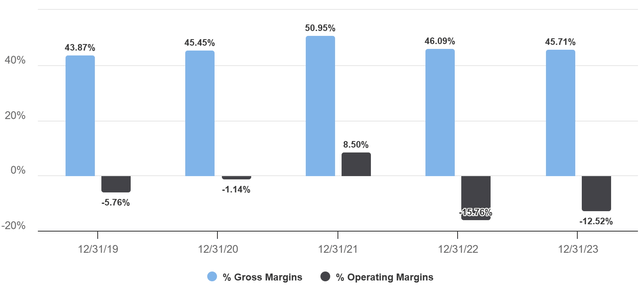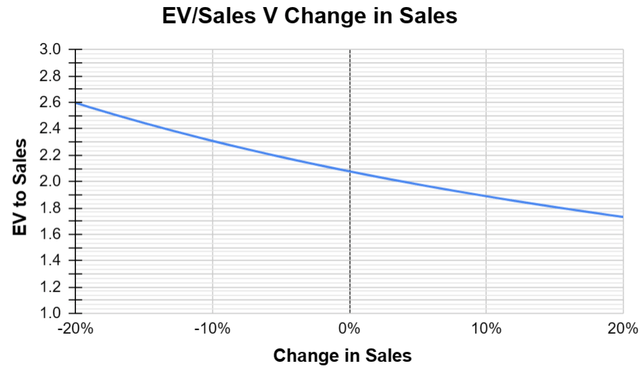Summary:
- My second coverage of Roku is a lot more optimistic than the first one but there is still work that needs to be done.
- The growth in numbers is accompanied by topline growth this time, but margins are still suffering.
- Sales and Marketing are still fueling the growth in a big way, but recent quarterly numbers are encouraging. It remains to be seen if this trend can continue.
- Valuation has improved tremendously, and it’s trading close to its lowest values relative to its history.
- Lack of a timeline for actual profitability and an expectation of above-average expected growth means the company might trend sideways longer than most investors anticipate.
RapidEye/E+ via Getty Images
I covered Roku (NASDAQ:ROKU) more than a year ago with a Strong Sell Rating. Some stocks do have a passionate following in the market and I knew Roku was one of them. But I was still surprised to see the reaction in the comments. I was told that I did not understand the grand vision of the business. Actual financials meant little as it was all about growth (Growth in subscriber numbers, not actual growth). But my thesis was simple.
1. Popular products do not always translate to a great business
2. Margins were taking a hit and all their marketing spend was not translating to meaningful revenues or actual revenue growth
3. The company was focusing on adjusted metrics, and this works less in a high-interest-rate world
4. The company was deviating from its core business and jumping on the AI bandwagon (I believe AI is the magic word companies can rely upon when the underlying business is suffering, and there was clear evidence that Roku was milking the trend)
5. The company was relying heavily on retail investors for funding growth (excessive dilution)
Bottom line, in the short term, my takeaway was there were better uses for your money than Roku, and it was important to separate the hype from an investment. It appears that I was right.
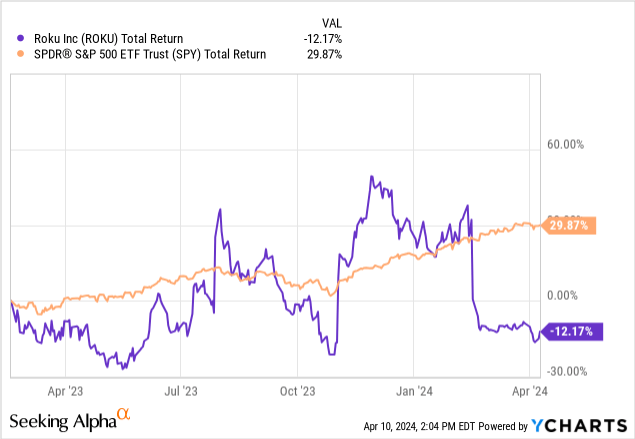
Subscriber Numbers are up, Topline is up but ARPU and Margins need work
A key difference between a year ago and now is that subscriber numbers are actually translating to increased revenues.
Number of Users over time (Statista)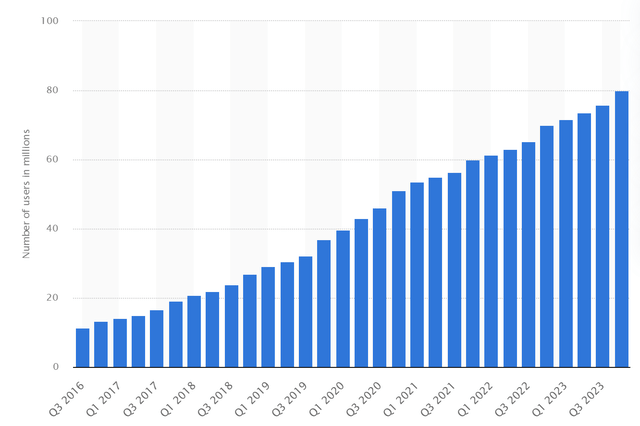
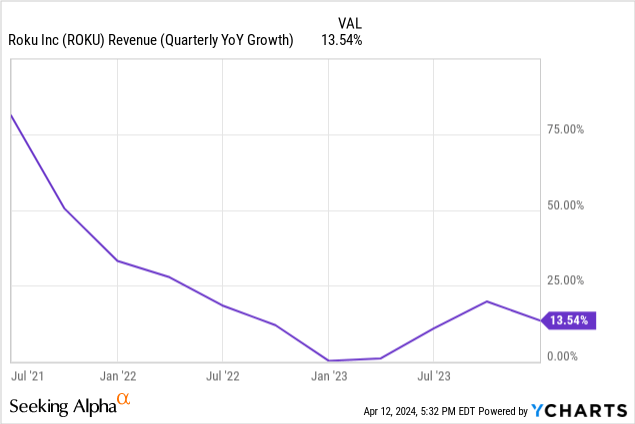
Active accounts are 80M, a growth of more than 14% from 2022, accompanied by an increase in streaming hours to 106B, up more than 20% YoY (Global Streaming Hours on the Roku platform grew 21% YoY, and Streaming Hours on The Roku Channel grew 63% YoY).
The good news is that unlike a year ago this has translated to growth in revenues. Total net revenue reached $3.5B, marking an 11% increase year over year (YoY). Platform revenue saw a rise of 10% YoY, reaching $3B. This performance reflects significant contributions from streaming services distribution activities and video advertising. While all this is good news, under the surface things are less certain.
1. Average Revenue Per User (ARPU) was $39.9, down 4% YoY
2. Gross Margins are slightly down from 2022
3. Operating Margins are headed in the right direction but are still suffering
Specifically, a year ago, I was seeing Sales and Marketing kick up a big notch (With revenue growth going down during that time, I could not understand where their marketing dollars were going). Fortunately, this time around I can see S&M coming under control for the quarter (-11% YoY) but revenues are still up by 14%. But for the full year, it is still a high percentage of revenues going towards S&M.
|
Total Revenues ($M) |
Marketing Expenses ($M) |
S&M/Revenues | |
| 2023 |
3480 |
1030 |
30% |
| 2022 | 3130 | 838.42 | 27% |
| 2021 | 2760 | 455.6 | 17% |
| 2020 | 1780 | 299.46 | 17% |
A welcome change from last year was when the company’s net losses were not only widening, but their adjusted profitability metrics were negative and widening as well! This time around, they have been able to achieve positive adjusted EBITDA and free cash flow for 2023. Not much, but a start. Their outlook does not mention when they will achieve actual profitability but promises this “over time”. They mainly attribute this to near-term challenges in the macro environment and an uneven ad market recovery. The company also faces rising competition in connected TV and the Walmart-Vizio deal is not likely to make things easier either.
As of now, investors will have to only contend with positive Adjusted EBITDA for 2024.
Dilution under control
I understand that Stock-Based compensation is a feature of young technology stocks and it offers companies a clever way of encouraging growth. A big complaint of mine last year was in addition to slowing growth and widening losses, the stock-based compensation to revenue was up and was at its highest compared to previous years at 12%. For 2023, it was comparatively lower which is a welcome sign.
| Date | Stock-Based Compensation to Revenue |
| 2023-12-31 | 10.6% |
| 2022-12-31 | 12% |
| 2021-12-31 | 7% |
| 2020-12-31 | 8% |
| 2019-12-31 | 8% |
| 2018-12-31 | 5% |
| 2017-12-31 | 2% |
Valuation is tough, EV/Sales offers hope
For a non-profitable company with only adjusted profitable metrics, a lot of the valuation ratios render themselves ineffective. The one metric you can lean on would be the Price to Sales multiple. On a sector basis alone this would look overvalued at 2.4x compared to the communication services sector median at 1.2x. One thing that plays well in Roku’s favor is its complete lack of debt. This means its EV/Sales multiple starts looking good at 2x compared to the sector median at 1.85x.
We can extrapolate this number and see that if the growth continues to hold or rise, the metric becomes more and more attractive. The below chart presents how this would look under different growth rates.
I like scenario-based forward-looking ratios, as they can account for uncertainty (which in the case of Roku is all the more important). If we see that the 11% growth rate continues to hold this year then the ratio EV/Sales will start heading lower to 1.9 and if it rises further from that, we could also see it dipping below the sector median. On the pessimistic side, if the revenue growth tanks (which is entirely possible considering the economic uncertainty and ad market competition etc.) we can see the ratio dip to 2.6x at a -20% fall in revenues.
From a historical perspective, what I have observed is that the company is trading close to its lowest levels. EV/Sales (NTM) estimates show that 98% of the time the company was trading at much higher values than what it is now.
Percentile Rank of Valuation (Koyfin)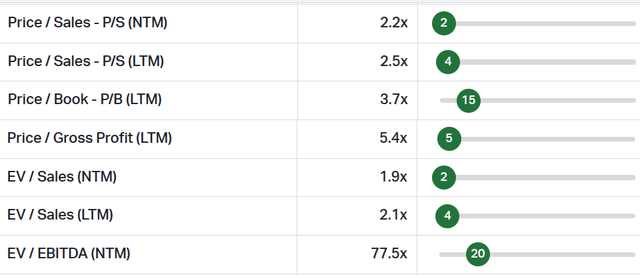
Upcoming Earnings and what to expect
Roku is scheduled to report its upcoming earnings on April 25 and the activity is already beginning to pick up. Wells Fargo cut its price target from $51 to $45 which is not encouraging. During the last earnings, we saw a 30% price move to the downside and we may see more instances of analysts trying to get ahead of such moves.
Final Call
I am upgrading my rating from Strong Sell to Sell. To summarize, the reasons for upgrading are the following:
1. The company continues to expand its market, and see increased adoption of its offerings and this correlates with topline numbers as well
2. Although ARPU is down, subscribers of today can contribute to its earnings tomorrow (It is the nature of ad business). From the revenue multiple alone, this looks attractive at current growth rates and will continue to get more attractive if growth rates hold up.
But this is still a Sell and the reasons for it still being a Sell, to summarize, are the following points:
1. Margins still need work. No mention of a timeline on when to expect actual profitability. In my opinion, this is not a good sign nor conducive to the current market environment.
2. There are much better names out there that can offer a better risk-to-reward profile. Investors buying here may have to contend with more sideways movement till the company figures out how to achieve full profitability. Unless the growth rates far exceed market expectations, the performance may continue to lag the market (Which is what we have seen in the last year).
Analyst’s Disclosure: I/we have no stock, option or similar derivative position in any of the companies mentioned, and no plans to initiate any such positions within the next 72 hours. I wrote this article myself, and it expresses my own opinions. I am not receiving compensation for it (other than from Seeking Alpha). I have no business relationship with any company whose stock is mentioned in this article.
Seeking Alpha’s Disclosure: Past performance is no guarantee of future results. No recommendation or advice is being given as to whether any investment is suitable for a particular investor. Any views or opinions expressed above may not reflect those of Seeking Alpha as a whole. Seeking Alpha is not a licensed securities dealer, broker or US investment adviser or investment bank. Our analysts are third party authors that include both professional investors and individual investors who may not be licensed or certified by any institute or regulatory body.

